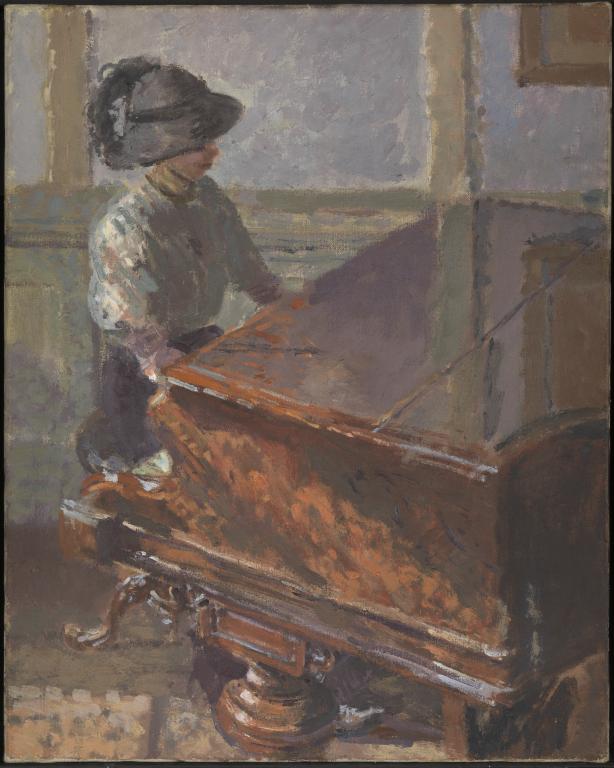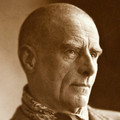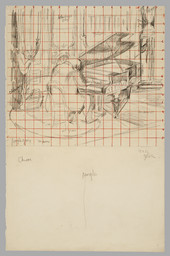Walter Richard Sickert Tipperary 1914
Walter Richard Sickert,
Tipperary
1914
The face of the young woman in this painting is obscured by a wide-brimmed black hat. Seen from above, she is posed as if in the midst of playing the Broadwood grand piano, which prominently fills the middle ground. Walter Sickert applied hues including green, red brown and a mushroom tone in layers of underpaint so as to evoke the reflection of coloured light, as in the highly polished wooden piano lid. His bold use of colour reflects the influence of the Camden Town Group. Although a depiction of life on the home front, the painting’s title refers to It’s a Long Way to Tipperary, a favourite marching tune of the British army during the First World War.
Walter Richard Sickert 1860–1942
Tipperary
1914
Oil paint on canvas
508 x 406 mm
Bequeathed by Lady Henry Cavendish-Bentinck 1940
N05092
1914
Oil paint on canvas
508 x 406 mm
Bequeathed by Lady Henry Cavendish-Bentinck 1940
N05092
Ownership history
Bought from the artist through Carfax & Co., London, by Lord Henry Cavendish-Bentinck, London, 1914; by descent to his widow, Lady Henry Cavendish-Bentinck, on his death 6 October 1931, by whom bequeathed to Tate Gallery 1940.
Exhibition history
1925
Seventy-First Exhibition of the New English Art Club, Spring Gardens Gallery, London, January–February 1925 (115).
1927
International Exhibition, Carnegie Institute, Pittsburgh, October–December 1927 (238).
1928
An Exhibition of Modern Art, The French Gallery, London, Autumn 1928 (18).
1947
?Sickert to Hodgkin, Lefevre Gallery, London, August 1947 (58, as ‘It’s a Long Way to Tipperary’).
1950
Some 20th Century English Paintings and Drawings: W.R. Sickert, P.W. Steer, Duncan Grant, Mark Gertler, Stanley Spencer, (Arts Council of Wales tour), National Library of Wales, Aberystwyth, July–September 1950, Glynn Vivian Art Gallery, Swansea, September–October 1950, National Museum of Wales, Cardiff, November 1950 (11).
1964
1914: An Exhibition of Paintings, Drawings and Sculpture, Baltimore Museum of Art, Maryland, October–November 1964 (21, reproduced).
1989–90
W.R. Sickert: Drawings and Paintings 1890–1942, Tate Gallery, Liverpool, March 1989–February 1990, Tate Gallery, London, July–September 1990 (11, reproduced).
1992–3
Sickert: Paintings, Royal Academy, London, November 1992–February 1993, Van Gogh Museum, Amsterdam, February–May 1993 (84, reproduced).
1998
Two British Impressionists: Walter Sickert and Philip Wilson Steer, Norwich Castle Museum, January–April 1998 (25, reproduced).
2003–4
Women and War, Imperial War Museum, London, October 2003–April 2004 (no number).
2004
Walter Richard Sickert: The Human Canvas, Abbot Hall Art Gallery, Kendal, July–October 2004 (29, reproduced).
2008
Modern Painters: The Camden Town Group, Tate Britain, London, February–May 2008 (93, reproduced).
References
1941
Robert Emmons, The Life and Opinions of Walter Richard Sickert, London 1941, p.179.
1955
Anthony Bertram, Sickert, London and New York 1955, reproduced pl.25.
1960
Lillian Browse, Sickert, London 1960, p.102, no.68, reproduced pl.68.
1961
John Rothenstein, Sickert, London 1961, [p.24], reproduced, as Tipperary, The Piano Picture.
1964
Mary Chamot, Dennis Farr and Martin Butlin, Tate Gallery Catalogues: The Modern British Paintings, Drawings and Sculpture, vol.2, London 1964, pp.630–1.
1973
Wendy Baron, Sickert, London and New York 1973, p.367.
1988
Richard Shone, Sickert, Oxford 1988, p.70.
1989
Paddy Kitchen, ‘In a Brown Study: Walter Sickert Exhibition’, Country Life, vol.183, no.11, 16 March 1989, reproduced p.124.
1991
Richard Cork, ‘WW1 Sickert rediscovered’, Art Newspaper, no.12, November 1991.
2000
Wendy Baron, Perfect Moderns: A History of the Camden Town Group, Aldershot and Vermont 2000, p.205.
2006
Wendy Baron, Sickert: Paintings and Drawings, New Haven and London 2006, no.447.1, pp.129, 427.
Technique and condition
Tipperary is painted on a commercial pre-primed canvas supplied by the artists’ colourmen J. Bryce-Smith. The cloth appears to be linen and has a fine plain weave, which has been sized and primed with a thin coat of zinc white bound in a tempera medium.1 Sickert had experimented with this type of preparatory surface prior to 1914 (see Tate N05088) and for a period seemed to prefer working on a lean surface. It may reflect early Whistlerian influences but also that of modern French painting and of a bolder use of colour through his association with the younger Camden Town Group painters.2 Paint has been applied directly onto the priming. The lower layers are lean where the oil has been absorbed by the primer and possibly by the canvas. Later layers are richer as the effect of the priming diminishes.
To create his composition the artist used colours of relatively pure hue, but pale and unmodulated, such as a green under the background, a mushroom colour under the top of the piano and the floor, and a stronger red brown under the piano side. The actual extent of this underpaint is not easy to identify. The red brown is applied as a thin wash, diluted with turpentine or a substitute. It shows the canvas texture clearly and has been rubbed down a little, perhaps accidentally when wet. The pale green and mushroom brushmarks are thicker and these may represent a second stage of painting over a now invisible layer. The first stage of work would have been allowed to dry and the next involved partial scrubbing over these well-dried layers with fairly lean opaque paint to impart local colour but also to ensure that much of the underpaint shows through between the isolated applications. In general, the artist’s brush loaded with dry paint has bounced across the texture underneath to create a broken film, but there is also some evidence of wet-in-wet mixing between the colours of the top layer. The underlayers appear to incorporate the depiction of reflected colour, which is a feature of this work, and paint has been applied sparingly in dabs to preserve this. The painting is unvarnished, retaining the matt impressionist aesthetic of the painting. At this period Sickert appears to be working toward a significant evolution in his technique.
Stephen Hackney
July 2004
Notes
How to cite
Stephen Hackney, 'Technique and Condition', July 2004, in Nicola Moorby, ‘Tipperary 1914 by Walter Richard Sickert’, catalogue entry, October 2004, in Helena Bonett, Ysanne Holt, Jennifer Mundy (eds.), The Camden Town Group in Context, Tate Research Publication, May 2012, https://wwwEntry
Background
In late 1914 and early 1915 Walter Sickert produced a number of images of women sitting at pianos, a variation of his visual exploration of the arrangement of figures within a Camden Town interior. As much prominence is given in the painting to the piano itself as to the player, reversing the usual balance of a concert picture. The model in Tipperary is a young woman dressed in a simple skirt and blouse with her face largely concealed by a wide-brimmed hat. She is sitting on a stool with her hands on the keyboard as though in the middle of playing. She sits at a grand piano which has ornate legs and a highly polished veneer; but this hint of luxury is not matched by the surroundings, which are plain and unremarkable. Little further information can be gleaned from the pictorial details, but Sickert introduces a wealth of evocative context by titling the painting Tipperary.
The title clearly refers to the famous wartime song It’s a Long Way to Tipperary and the viewer is positioned looking down at the pianist as though standing among a crowd grouped around for a sing-song in a pub or a private room. The song was written and published in 1912 by Jack Judge and Harry Williams, but it achieved lasting fame during the First World War after it was adopted by the 7th Battalion of the Connaught Rangers, an Irish regiment in the British army. It quickly became a favourite marching tune throughout the armed forces at the Front, probably because of its jaunty melody, the references in the lyrics to familiar London place names, and the song’s sentiment of being far from home and loved ones. In Sickert’s painting the lone female figure is a suggestive visual reminder of the absence of many young men at this time. The song has three verses interspersed with the chorus:
Up to mighty London came an Irishman one day,
As the streets are paved with gold, sure ev’ryone was gay;
Singing songs of Piccadilly, Strand and Leicester Square,
’Til Paddy got excited, then he shouted to them there:–
[Chorus]
It’s a long way to Tipperary, it’s a long way to go;
It’s a long way to Tipperary, to the sweetest girl I know;
Goodbye Piccadilly, farewell Leicester Square,
It’s a long, long way to Tipperary, but my heart’s right there.
As the streets are paved with gold, sure ev’ryone was gay;
Singing songs of Piccadilly, Strand and Leicester Square,
’Til Paddy got excited, then he shouted to them there:–
[Chorus]
It’s a long way to Tipperary, it’s a long way to go;
It’s a long way to Tipperary, to the sweetest girl I know;
Goodbye Piccadilly, farewell Leicester Square,
It’s a long, long way to Tipperary, but my heart’s right there.
Paddy wrote a letter to his Irish Molly O’,
Saying, ‘Should you not receive it, write and let me know!
If I make mistakes in spelling, Molly, dear,’ said he,
‘Remember it’s the pen that’s bad, don’t lay the blame on me.’
Saying, ‘Should you not receive it, write and let me know!
If I make mistakes in spelling, Molly, dear,’ said he,
‘Remember it’s the pen that’s bad, don’t lay the blame on me.’
Molly wrote a near reply to Irish Paddy O’,
Saying, ‘Mike Maloney wants to marry me, and so
Leave the Strand and Piccadilly, or you’ll be to blame,
For love has fairly drove me silly, hoping you’re the same.’
Saying, ‘Mike Maloney wants to marry me, and so
Leave the Strand and Piccadilly, or you’ll be to blame,
For love has fairly drove me silly, hoping you’re the same.’
The First World War also saw the creation of an extra unofficial verse very much in the tradition of saucy music hall comedy:
That’s the wrong way to tickle Mary, that’s the wrong way to kiss!
Don’t you know that over here, lad, they like it best like this!
Hooray pour le Français! Farewell, Angleterre!
We didn’t know the way to tickle Mary, but we learned how, over there!
Don’t you know that over here, lad, they like it best like this!
Hooray pour le Français! Farewell, Angleterre!
We didn’t know the way to tickle Mary, but we learned how, over there!
Sickert and the First World War
The impact of the First World War upon Sickert’s life and work, documented in his wartime correspondence with his friends Ethel Sands and Nan Hudson, was general and abstract rather than specific and direct. His attitude towards the war was one shared by many British citizens at the time, although Sickert, in the event, was luckier than most in not suffering the loss of close family or friends in the fighting. Sickert himself was born in Germany and after the outbreak of war was compelled to get proof of his Danish father’s naturalisation from the Home Office to avoid being monitored or interned as a foreigner.1 Although he had fond memories of living in Germany as a child, his sympathies lay entirely with the Allies.2 He was utterly horrified by the invasion of Belgium and France by the ‘bloody Germans’, and followed the unfolding events with anxiety for Dieppe and the other places in France he had so frequently visited. In contrast to the pacifist principles shared by many other artists such as the Bloomsbury Group, Sickert held the opinion that the war was a necessary evil and would soon prove a decisive victory for the Allies. He told Sands: ‘this horror as I call it is probably the best thing possible. The German Empire had to be smashed (if smashed it is to be!) so that we may all live in peace & not be taxed out of our wits.’3 At the age of fifty-four he was too old to enlist and expressed frustration at not being able to play an active role:
The amazing Scot Tommies I have seen in bars in London with great goatskin waistcoats explaining where their last bullet came in & where it went out have certainly less studios & press-notices than I have but I am sure they are much more exhilarated.4
In common with many civilians, however, he had a limited understanding of the true nature of mechanised warfare or the horrendous conditions faced by soldiers on the Western Front. He wrote rather disingenuously to Sands: ‘All round I feel happy about the war but the wearing effect of it is worse on us non-combatants than on a soldier. All my soldier friends are so well & happy, [Philip Connard] told me today painting is so much more difficult & laborious.’5 At one point there was a suggestion that he might actually be sent to the Front to sketch for the Prime Minister,6 but this never happened. Furthermore he never sought to become an official war artist and was the only British artist of significance who declined the offer to participate in the work of the British War Memorials Committee.7 The small number of images by Sickert featuring wartime subjects includes The Soldiers of King Albert The Ready 1914 (Graves Art Gallery, Sheffield),8 The Integrity of Belgium 1914 (Government Art Collection),9 and the painting Wounded 1915 (fig.1) and its etching Red Cross 1915,10 which depict a nurse attending to a wounded soldier. The information that lay behind Sickert’s First World War paintings, however, was gleaned from the media and from the experiences of others, or, like Tipperary, reflected life on the home front.
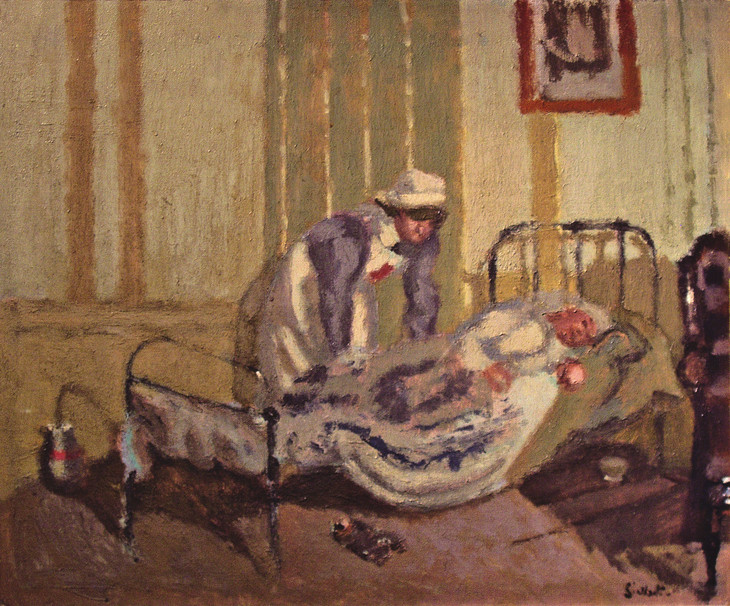
Walter Richard Sickert 1860–1942
Wounded 1915
Oil paint on canvas
635 x 762 mm
Private collection
© Estate of Walter R. Sickert / DACS
Fig.1
Walter Richard Sickert
Wounded 1915
Private collection
© Estate of Walter R. Sickert / DACS
Soldiers everywhere. Trains of them pass above me on the way to battle. Regiments pass me on the way to my office. The song of the day for them is ‘Here we are! Here we are! Here we are again!’ When we do take the offensive it will be a walk-over. At least that is what we think at the Bedford Music Hall.11
Such cheerful gung-ho patriotism accurately reflected the enthusiastic spirit of public opinion. The music halls played a significant role in maintaining a buoyant morale among the populace. Nationalistic marching tunes and comic songs expressing anti-German sentiment became a standard part of the bill. It’s a Long Way to Tipperary featured in the repertoire of the popular music hall entertainer, Florrie Forde (see Spencer Gore’s A Singer at the Bedford Music Hall, Tate T02260).12 Forde was a regular fixture at many London music halls and it was possibly through her popular version of Tipperary that Sickert became familiar with the song.
‘Chicken’
Sickert’s letter to Sands identifies the model for Tipperary as ‘Chicken’, a chorus girl at the Royal Opera House whom Sickert regularly employed as a model between about 1908 and 1915. Her real name was Emily Powell. She lived with her family in the same building as Sickert’s rented studio at 26 Red Lion Square, and her unmistakable features are identifiable in a number of paintings from the Camden Town period. In 1914 she would have been about seventeen years old.13 Chicken embodied the type of authentically working or lower middle class Camden Town woman whom Sickert preferred to paint: a stereotype he christened ‘Tilly Pullen’ in an essay of 1910.14 A portrait of her painted in around 1914 shows her to have been a young woman with dark hair, wide-set eyes in a comically round face and irregular teeth with an immensely appealing expression (private collection).15
John Wood Palmer, writing in an exhibition catalogue of 1963, described Chicken as someone who ‘clearly must have adored her stout and would have rocked in drunken song in the ale house on the jolliest behind’.16 This was resolutely denied by Sylvia Gosse who reported that despite being from a poor family Chicken was a respectable girl and was ‘certainly no drunkard’.17 Gosse recorded that Chicken loved dressing up but had to make do with any available clothes that came her way.18 In the 1914 portrait she wears the same white blouse with an oval fastening at the neck and dark, wide-brimmed hat in which she appears in Tipperary. In late 1914 Chicken sat for Sickert every day between 10 am and 4 pm enabling the artist to complete ‘some real beauties’.19 Another painting from 1914, also entitled Tipperary (private collection), 20 shows a soldier in khaki leaning out of a window beside a mirror which reflects Chicken in profile at the piano. The art historian Wendy Baron has surmised that this is probably the picture Sickert was referring to when he wrote to Hudson: ‘Chicken has been playing the contes d’Hoffman [Tales of Hoffman, an opera by Jacques Offenbach] while I have been painting her reflection at the piano.’21
Related works
Tate’s version of Tipperary is possibly one of a ‘series of direct little pictures’ measuring 20 x 16 inches which Sickert told Sands in a letter included a subject called ‘Gladys by the piano’.22 An illustration accompanying the letter identifies one of the series as Wellington House Academy, a canvas inscribed to Sickert’s friend, the poet W.H. Davies (fig.2).23 The pianist is an unidentified woman called ‘Gladys’, although Sickert may have invented this name. Her face is reflected in the lid of the instrument. A man, probably the male model and factotum for Sickert known as Hubby (see Tate N03846), listens in the background. Two related preparatory drawings exist: The Baby Grand c.1914 (fig.3),24 a compositional sketch in pencil, pen and ink and chalk; and Study for ‘Tipperary’, The Piano Picture 1914 (private collection),25 in chalk, pen and ink, a detailed study of the appearance and pose of the pianist. Despite these obvious indications of careful planning and preparation, the painting itself has been executed in an impressionist manner. It is a study of reflected light, and the painted polish on the piano lid is a tour de force. The paint has been applied briskly with broken brushstrokes giving the scene a sense of immediacy and informality. Sickert was pleased with the technique which he described as ‘thin free or hard rubs of paint mixed with turpentine’.26 When the picture was exhibited at the French Gallery, London, in 1927, it was praised for its ‘delightful’ colour and draughtsmanship. The critic of the Sunday Dispatch rejoiced that the ‘picture easily holds its own with the French exhibits’.27
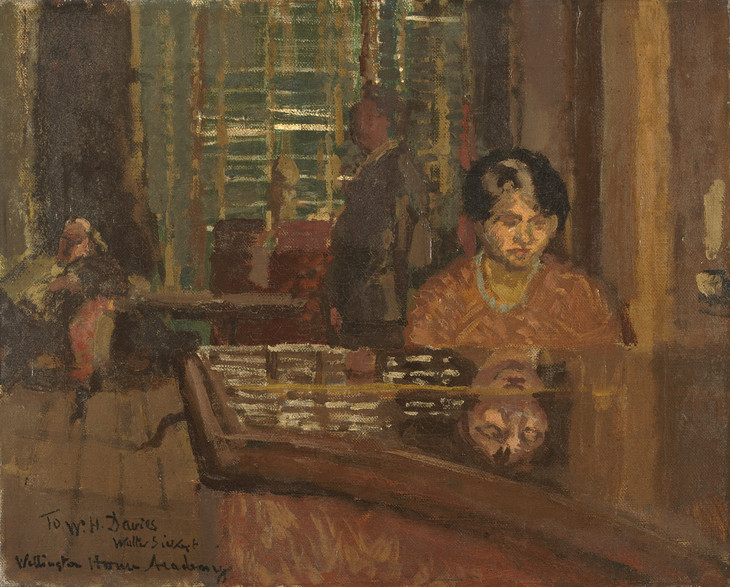
Walter Richard Sickert 1860–1942
Wellington House Academy 1914
Oil paint on canvas
410 x 510 mm
Fife Council Libraries & Museums: Kirkcaldy Museum & Art Gallery
© Estate of Walter R. Sickert / DACS
Photo © Antonia Reeve
Fig.2
Walter Richard Sickert
Wellington House Academy 1914
Fife Council Libraries & Museums: Kirkcaldy Museum & Art Gallery
© Estate of Walter R. Sickert / DACS
Photo © Antonia Reeve
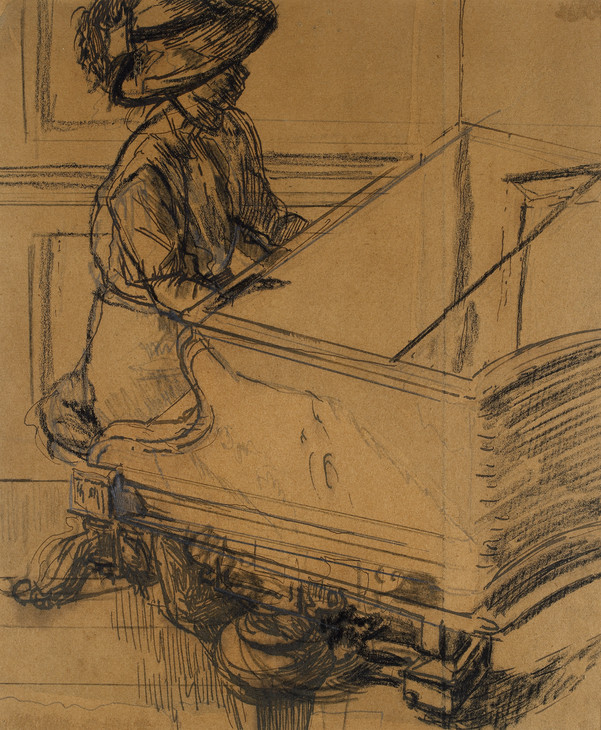
Walter Richard Sickert 1860–1942
The Baby Grand c.1914
Pencil, chalk and pen and ink
33 x 28 cm
Ashmolean Museum, Oxford
© Estate of Walter R. Sickert / DACS
Photo © Ashmolean Museum, Oxford
Fig.3
Walter Richard Sickert
The Baby Grand c.1914
Ashmolean Museum, Oxford
© Estate of Walter R. Sickert / DACS
Photo © Ashmolean Museum, Oxford
A number of other models posed for Sickert at the piano. The artist used the theme, like the iron bedsteads and the mantelpiece, as a way to explore figurative compositions within an interior, manipulating the space and the relationship between people and their surroundings. The earliest example seems to have been an untraced study of Adolphe Tavernier’s daughter at the piano which Sickert told Sands was pleasant to undertake since he could listen to Beethoven.28 In January 1914, Sickert published a drawing in the New Age entitled The Music Lesson, which depicts Chicken leaning on the keyboard of a piano with the figure of Hubby behind her.29 A further drawing of the pair, showing Chicken in profile, was given to Osbert Sitwell in exchange for a pair of cufflinks.30 Chicken was probably also the model for a series of images showing the side view of a woman in a hat playing the piano: an oil painting on canvas, Chopin (private collection);31 a drawing, Girl at Piano: ‘Chopin’ (Wakefield Art Gallery);32 and an engraving, Kitty K c.1915 and 1920.33 Other drawings include, Chicken. Girl Playing a Piano 1914 (whereabouts unknown),34 The Afternoon Rest; Woman at a Piano 1914 (Whitworth Art Gallery, Manchester),35 and a charcoal sketch, At the Piano, Miss Ethel Sands (private collection).36 Sickert also seems to have encouraged Sands and Hudson to tackle the theme. Correspondence between the master and his pupils indicates that the two women also painted Chicken and Hubby at the piano under the direction of their mentor.
The type of piano which Sickert owned and kept in his studio at Red Lion Square was a Broadwood Grand, an instrument made by the famous British manufacturer John Broadwood and Sons, one of the oldest and most prestigious piano companies in the world. Physical details characteristic of nineteenth-century Broadwood grands are visible in Tipperary, for example the heavy projecting corner block on the treble cheek (the curved wooden edge on either side of the keyboard). In particular, the piano in Sickert’s painting resembles a model dating from around 1889 which included features such as the double band of moulding around the bottom of the case side, the plain turned leg and the rectangular decorative moulding on the leg block.37 The wood of the piano is probably rosewood or Italian walnut. Morton Sands, nephew of Ethel, claimed that the piano passed to his family. On at least one occasion Sickert’s Broadwood grand was put through its paces by Zina Drummond who played to the artist ‘like a siren’ after a sitting.38 Zina Drummond (née Ogilvie), the wife of Sickert’s fellow Camden Town member, Malcolm Drummond, was an artist herself but was also a talented pianist. She was painted by her husband in Arabesque at the Piano; Zina Ogilvie, the Artist’s Wife 1910–12,39 and probably also in At the Piano c.1912 (Art Gallery of South Australia, Adelaide).40
Ownership
In 1914 Sickert told Sands that ‘dear Ld. Henry [Bentinck] is hovering on the verge of the purchase of my piano picture of Chicken’.41 Lord Henry Cavendish-Bentinck (1863–1931), the brother of Lady Ottoline Morrell, was a regular collector of Sickert’s work (see Tate N05088). He bought Tipperary in 1914 from the Carfax Gallery (a label on the back of the canvas testifies to this). The painting of an apparently working class London girl seems an unlikely choice of subject for someone from an aristocratic background, but its patriotic associations possibly appealed to him at a time when nationalistic fervour was sweeping the country. Furthermore, Bentinck and his sister patronised and collected the work of a number of modern British artists (see Tate N05088).
Fired by patriotic enthusiasm and despite being aged fifty-two, Lord Bentinck joined up in 1915 and Sickert bemoaned the departure of one his best patrons to the Front.42 However, in common with many, he suffered disillusionment with the war. Having served in the Dardanelles he became seriously ill with dysentery and nearly died. He was discharged from the army and Ottoline Morrell wrote after seeing him on his return to London, ‘he is very depressed and showed no sign of pleasure at seeing me, which disappointed me but I feel he has seen such horror, that it has taken all the life and spirit out of him’.43 Their brother, Lord Charles Bentinck, also served in the disastrous campaign at Gallipoli and was wounded twice. Lord Henry Bentinck frequently lent paintings from his collection to public exhibitions.
Nicola Moorby
October 2004
Notes
Walter Sickert, letter to Ethel Sands, undated [August or September 1914], Tate Archive TGA 9125/5, no.146.
Reproduced in Ruth Bromberg, Walter Sickert Prints: A Catalogue Raisonné, New Haven and London 2000, no.162.
Walter Sickert, ‘The Study of Drawing’, New Age, 16 June 1910, p.156, in Anna Greutzner Robins (ed.), Walter Sickert: The Complete Writings on Art, Oxford 2000, p.247.
Wendy Baron, Sickert: Paintings and Drawings, New Haven and London 2006, no.447; reproduced in Royal Academy 1992, fig.169, p.244.
Walter Sickert, letter to Nan Hudson, [First World War – 1914 October?], Tate Archive TGA 9125/5, no.35.
Ibid., no.447.6; reproduced in Sickert: Drawings, exhibition catalogue, Art Gallery of Western Australia, Perth 1979, fig.58.
‘Chicken’, Girl at a Piano c.1914–15, pen, ink and black chalk on paper; reproduced in Osbert Sitwell (ed.), A Free House! Or The Artist as Craftsman: Being the Writings of Walter Richard Sickert, London 1947, between pp.xvi–xvii.
Reproduced in Baron 2006, no.447.2 and Modern British and Irish Paintings, Watercolours, Drawings and Sculpture, Christie’s, London, 23 November 1993 (lot 49).
Baron 2006, no.447.7; reproduced in Walter Sickert: ‘drawing is the thing’, exhibition catalogue, Whitworth Art Gallery, Manchester 2004 (2.21).
Baron 2006, no.410.2; reproduced at the Whitworth Art Gallery, Manchester, http://www.whitworth.manchester.ac.uk/collection/ .
Reproduced in British and Irish Modernist and Contemporary Paintings, etc., Christie’s, London, 9 March 1990 (lot 203).
Serial number 22,429. Information supplied by Dr A.D. Laurence, John Broadwood and Sons Ltd., October 2004.
Reproduced in Wendy Baron, Perfect Moderns: A History of the Camden Town Group, Aldershot and Vermont 2000, p.107.
Related biographies
Related essays
Related archive items
Related reviews and articles
- Walter Richard Sickert, ‘The Study of Drawing’ The New Age, 16 June 1910, pp.156–7.
Related audio
-
Florrie Forde 1875–1940 performs 'It's a Long Way to Tipperary' recorded August 1929© Windyridge Music Hall CDs
-
Jack Judge 1872–1938 performs 'It's a Long Way to Tipperary' recorded July 1915© Windyridge Music Hall CDs
Related film
-
Conservator Stephen Hackney on Walter Sickert's Tipperary 1914© 2011 Tate
How to cite
Nicola Moorby, ‘Tipperary 1914 by Walter Richard Sickert’, catalogue entry, October 2004, in Helena Bonett, Ysanne Holt, Jennifer Mundy (eds.), The Camden Town Group in Context, Tate Research Publication, May 2012, https://www

